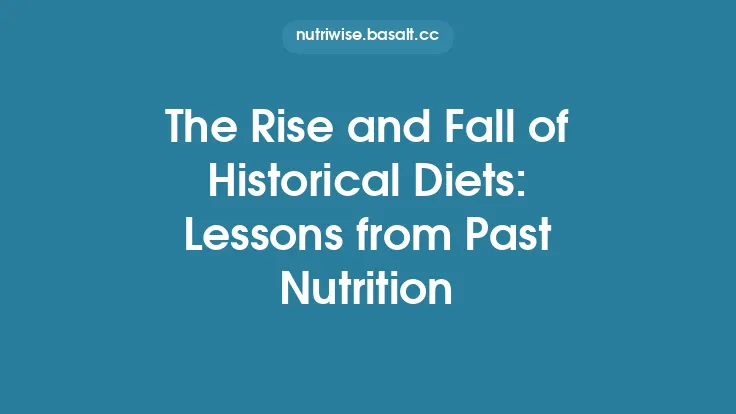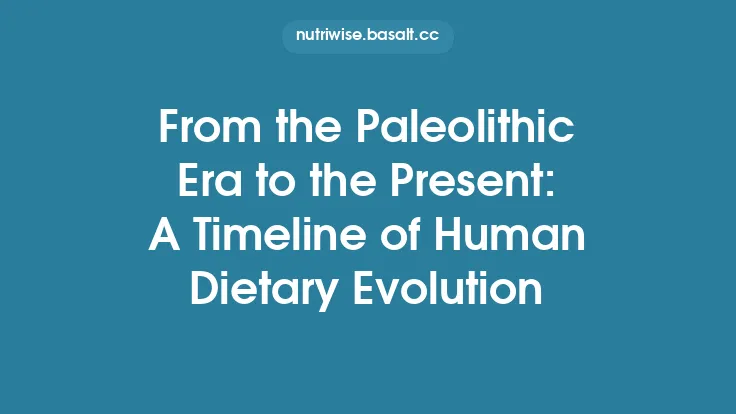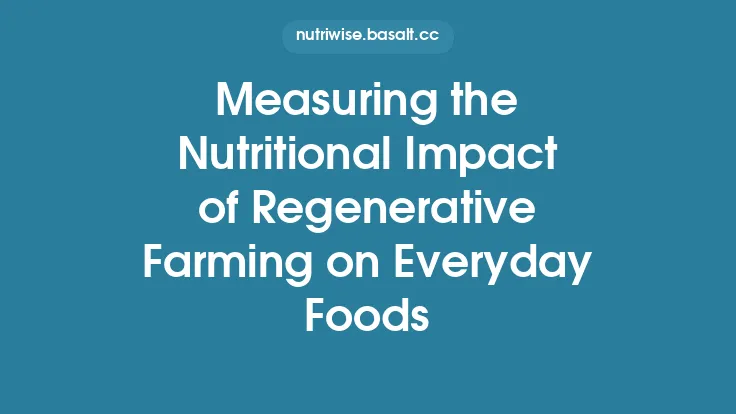The transition from a nomadic, foraging way of life to settled agriculture marks one of humanity’s most profound shifts. While the cultural, technological, and societal ramifications of this change have been explored from many angles, its direct influence on the nutrients that sustained early peoples remains a cornerstone for understanding both ancient health patterns and the foundations of modern nutrition. By examining the dietary composition of hunter‑gatherers, the early crops they cultivated, and the physiological outcomes that followed, we can trace how the Agricultural Revolution reshaped the human body and set the stage for contemporary nutritional science.
The Foraging Lifestyle and Its Nutritional Profile
For millennia, human groups survived by exploiting a mosaic of wild resources—seasonal fruits, nuts, tubers, leafy greens, insects, and animal protein obtained through hunting and fishing. This eclectic diet was inherently variable, reflecting local ecosystems and seasonal cycles. Several key nutritional characteristics defined the forager’s intake:
- High Micronutrient Density – Wild greens and berries are rich in vitamins A, C, and K, as well as minerals such as magnesium, potassium, and trace elements (e.g., zinc, selenium). The diversity of plant parts consumed (roots, shoots, fruits) ensured a broad spectrum of phytonutrients and antioxidants.
- Balanced Fatty Acid Ratios – Animal sources provided long‑chain polyunsaturated fatty acids (EPA, DHA) essential for brain development, while plant foods contributed omega‑6 fatty acids, resulting in a relatively balanced n‑6/n‑3 ratio compared with later agricultural diets.
- Protein Quality and Quantity – Though total protein intake varied, the inclusion of wild game, fish, and insects supplied all essential amino acids in proportions closely matching human requirements.
- Fiber and Resistant Starch – Unprocessed plant foods delivered substantial dietary fiber, promoting a healthy gut microbiome and aiding glycemic regulation.
- Caloric Variability – Energy intake fluctuated with resource availability; periods of abundance were interspersed with leaner intervals, fostering metabolic flexibility.
Overall, the forager diet was nutrient‑dense but calorically modest, supporting a lean physique, robust immune function, and relatively low incidences of chronic disease.
The Advent of Cultivation: Early Agricultural Practices
Around 12,000 years ago, climatic stability after the last glacial maximum created conditions favorable for plant domestication. Early agriculturalists began to select and sow seeds from wild cereals (e.g., einkorn, emmer), legumes (e.g., lentils, peas), and tuberous crops (e.g., wild potatoes). The shift from opportunistic gathering to intentional sowing introduced several nutritional consequences:
- Monoculture Tendencies – Even in the earliest fields, a limited number of species dominated the cultivated landscape, reducing dietary diversity.
- Increased Carbohydrate Availability – Domesticated cereals and legumes offered higher yields of storable carbohydrates, allowing for surplus production and year‑round consumption.
- Reduced Animal Protein – Sedentary settlements required fewer large‑game hunts; livestock were kept primarily for traction or secondary products, decreasing the proportion of animal protein in the average diet.
- Processing Requirements – Grains needed to be hulled, ground, and cooked, introducing energy losses (e.g., loss of bran and germ) that altered the nutrient profile of the final food.
These changes laid the groundwork for a diet increasingly centered on plant‑derived macronutrients.
Macronutrient Shifts: From Wild Foods to Domesticated Crops
Carbohydrates
The most striking alteration was the surge in carbohydrate intake. While foragers obtained carbs from a variety of sources (fruits, tubers, honey), early farmers derived the bulk of their energy from cereals. A typical Neolithic diet could consist of 70–80 % of calories from carbohydrates, compared with 30–40 % for hunter‑gatherers. This shift had several implications:
- Glycemic Load – Whole grains contain complex starches, but early processing (e.g., stone grinding) often produced finer flours with higher glycemic indices, leading to more rapid post‑prandial glucose spikes.
- Energy Density – The caloric yield per hectare of cultivated cereals far exceeded that of wild plants, supporting larger, more permanent populations.
Proteins
Protein intake declined both in absolute terms and in quality. While legumes contributed essential amino acids, they lacked the complete profile of animal proteins. Consequently, the average protein-to‑energy ratio fell from roughly 15 % in forager societies to 10–12 % in early agricultural communities.
Fats
The proportion of dietary fat dropped markedly. Wild diets featured significant animal fat and occasional nuts, whereas cultivated diets were low in lipids, relying primarily on plant oils that were scarce in early agrarian contexts. This reduction contributed to lower overall caloric density and altered fatty‑acid composition, with a relative increase in omega‑6 fatty acids from plant sources.
Micronutrient Consequences of Early Farming
The narrowing of food variety inevitably impacted micronutrient intake:
- Iron and Zinc – Heme iron from meat and zinc from animal tissue were abundant in forager diets. Plant‑based iron (non‑heme) is less bioavailable, and phytates in cereals further inhibit absorption, leading to higher rates of iron‑deficiency anemia in early farming populations.
- Vitamin A and D – Wild animal liver and fatty fish supplied preformed vitamin A and D. In agrarian societies, these nutrients were largely absent, increasing susceptibility to night blindness and rickets, especially in higher latitudes.
- B‑Vitamins – Cereals are rich in thiamine, riboflavin, and niacin, yet the removal of bran during milling reduced these levels. Populations that relied heavily on polished grains experienced pellagra‑like symptoms before the discovery of niacin’s role.
- Calcium – Without dairy or bone‑rich animal foods, calcium intake fell, contributing to reduced bone mineral density in some archaeological samples.
These deficiencies were not uniform; regional variations in crop selection, supplemental foraging, and animal husbandry mitigated or exacerbated specific micronutrient gaps.
Health Implications: Disease, Stature, and Longevity
Archaeological and bio‑anthropological evidence reveals measurable health shifts coinciding with the Agricultural Revolution:
- Increased Pathogen Load – Sedentary villages facilitated the spread of water‑borne and zoonotic diseases (e.g., dysentery, helminth infections). Poor sanitation and close proximity to domesticated animals amplified exposure.
- Stature Decline – Skeletal remains indicate a modest reduction in average adult height (approximately 5–10 cm) after the adoption of agriculture, reflecting chronic nutritional stress and disease burden.
- Dental Health – Caries rates rose dramatically due to higher carbohydrate consumption, while dental wear decreased because of softer, processed foods.
- Longevity Patterns – While overall life expectancy at birth fell because of higher infant mortality, individuals who survived childhood often lived as long as their forager counterparts, suggesting that the nutritional deficits primarily affected early development rather than adult health.
These outcomes underscore the complex trade‑off between food security (through surplus production) and nutritional quality.
Population Growth and Nutritional Demands
The caloric surplus generated by agriculture enabled unprecedented population expansion. Estimates suggest that global human numbers rose from roughly 5 million to 50 million within a few millennia. However, this growth placed new pressures on the food system:
- Land Use Intensification – To feed larger groups, societies cleared additional land, often reducing biodiversity and further limiting the availability of wild, nutrient‑rich foods.
- Nutrient Recycling – Early agrarian communities developed practices such as crop rotation and fallow periods to maintain soil fertility, indirectly influencing the micronutrient content of subsequent harvests.
- Social Allocation – Surplus production allowed for the emergence of social hierarchies, where elite groups could access higher‑quality foods (e.g., meat, fish, exotic fruits), while the majority subsisted on staple grains.
Thus, the nutritional landscape became intertwined with demographic and social dynamics.
Socioeconomic Stratification and Access to Nutrition
The ability to store and control grain surpluses gave rise to centralized authority and differentiated access to food resources:
- Elite Diets – Archaeological sites associated with ruling classes often contain remains of meat, fish, and imported foods, indicating a more varied and nutrient‑dense diet.
- Commoner Rations – The bulk of the population relied on coarse grain porridges and flatbreads, with limited animal protein. This disparity contributed to health differentials observable in skeletal markers of stress and disease.
- Gendered Nutrition – In many early farming societies, women’s diets were more plant‑centric, reflecting labor divisions and cultural norms, which may have impacted reproductive health and maternal outcomes.
Understanding these inequities provides context for modern discussions about food security and nutrition justice.
Environmental Feedbacks and Soil Nutrient Dynamics
Agriculture altered the very substrate that supplied nutrients:
- Soil Depletion – Continuous cultivation of the same crops without adequate replenishment of nitrogen, phosphorus, and potassium led to declining soil fertility, which in turn reduced the micronutrient density of harvested grains.
- Manuring Practices – Some early societies incorporated animal manure, enhancing nitrogen availability and modestly improving protein content in crops.
- Crop Diversity as a Buffer – Regions that maintained a mosaic of cereals, legumes, and root crops generally experienced less severe nutrient declines, illustrating the early recognition—whether intentional or incidental—of the benefits of diversified agriculture.
These environmental interactions highlight the feedback loop between human nutrition and ecosystem health.
Legacy of the Agricultural Revolution in Modern Nutrition
The imprint of early farming persists in contemporary dietary patterns:
- Staple Grain Dependence – Wheat, rice, and maize dominate global caloric intake, a direct lineage from the first domesticated cereals.
- Micronutrient Fortification – Modern public‑health initiatives (e.g., iron‑fortified flour, vitamin‑A‑enriched oil) aim to correct the deficiencies that originated with the shift to grain‑centric diets.
- Nutrition Transition – As societies industrialize, the historical baseline of high‑carbohydrate, low‑fat diets is supplanted by processed foods, yet the underlying macronutrient imbalance—excess carbs, insufficient quality protein and fats—remains a challenge rooted in the Agricultural Revolution.
- Re‑wilding and Diversification – Contemporary movements to reintroduce ancient grains, legumes, and foraged foods reflect a desire to recapture the nutrient density of pre‑agricultural diets while retaining the food security benefits of cultivation.
By recognizing the nutritional consequences of humanity’s first large‑scale experiment with farming, we can better design diets and agricultural systems that honor both health and sustainability.





